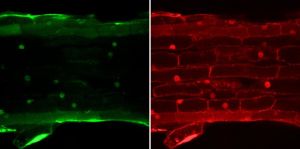Both profit from the symbiotic community: From their host plants, arbuscular mycorrhiza fungi (AM fungi) collect carbohydrates from photosynthesis. In return, they supply their host plants with nitrogen or phosphate, nutrients that can hardly be accessed by the plant. Plant pathogens, by contrast, damage their host plant. A team of the KIT Botanical Institute has studied how plants succeed in distinguishing between friend and enemy. The results were published in the journal “Current Biology”.
It has been happening directly below ground surface for millions of years now: Interaction between fungi and plants. Thanks to microscopically small organisms, the arbuscular mycorrhiza fungi (AM fungi), the plant grows and growth is improved. Pathogenic fungi are the ‘bad brothers’ of these AM fungi: They reproduce at the expense of their host, damage the plant or even kill it. How can the plant distinguish between friend and enemy? Why does the plant not show its typical defense reactions against pathogenic fungi when it is colonized by AM fungi? These questions were studied by the working group “Plant-microbe Interactions” headed by Professor Natalia Requena at the Botanical Institute of KIT. The scientists found that AM fungi are able to communicate with their plant partner. A protein secreted by the fungus acts as signal substance.
The researchers found that this protein is taken up by the plant cells, interacts with a protein of the plant in the nuclei, and, thus, “rewrites” the cellular program of the plant partner. In this way, the fungus can suppress the triggering of defense mechanisms. Molecules causing such a transformation are called effectors. In numerous pathogenic microorganisms, such proteins have already been discovered and their functioning was studied. However, never before was it confirmed that this mechanism is also used by symbiotic fungi to influence their host. The protein SP7 discovered by Requena’s team is the only effector described for AM fungi so far. This finding may lead to a better understanding of this useful symbiosis and possibly pave the way for an optimized use of AM fungi in sustainable agriculture.
“The difficulty of working with AM fungi lies in the fact that the fungi can only be cultivated together with their plant partner. This makes it difficult to produce sufficient fungi material for analysis,” says Silke Kloppholz from the Botanical Institute. Furthermore, it has been impossible so far to genetically manipulate AM fungi. Many standard molecular biology methods could not be applied to these fungi. Natalia Requena and her colleagues first had to optimize existing methods for successful investigation of the fungus material in spite of its small amount. In addition, they use bypasses such as the genetic manipulation of the plant partner or other genetically accessible fungi to obtain more information on the functioning of the fungal protein in the plant.
Literature:
Kloppholz et al., A Secreted Fungal Effector of Glomus intraradices Promotes Symbiotic Biotrophy, Current Biology (2011), doi:10.1016/j.cub.2011.06.044
In close partnership with society, KIT develops solutions for urgent challenges – from climate change, energy transition and sustainable use of natural resources to artificial intelligence, sovereignty and an aging population. As The University in the Helmholtz Association, KIT unites scientific excellence from insight to application-driven research under one roof – and is thus in a unique position to drive this transformation. As a University of Excellence, KIT offers its more than 10,000 employees and 22,800 students outstanding opportunities to shape a sustainable and resilient future. KIT – Science for Impact.

